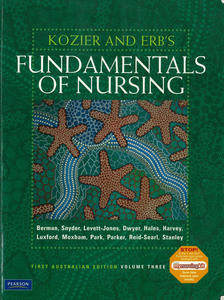Sensory perception
Harvey, Nichole (2010) Sensory perception. In: Berman, Audrey, Snyder, Shirlee J., Kozier, Barbara, Erb, Glenora, Levett-Jones, Tracy, Dwyer, Trudy, Hales, Majella, Harvey, Nichole, Luxford, Yoni, Moxham, Lorna, Park, Tanya, Parker, Barbara, Reid-Searl, Kerry, and Stanley, David, (eds.) Kozier and Erb's Fundamentals of Nursing. Pearson Australia, Frenchs Forest, NSW, Australia, pp. 1032-1055.
![[img]](https://researchonline.jcu.edu.au/16209/1.hassmallThumbnailVersion/16209_Harvey_2010_Book_cover.jpg)
|
Image (JPEG) (Book Cover)
- Cover Image
Download (2MB) |
|
|
PDF (Published Version)
- Published Version
Restricted to Repository staff only |
Abstract
For years Kozier & Erb’s Fundamentals of Nursing has been the gold standard in helping students embarking on their nursing careers. This first Australian edition retains many of the features that have made this textbook the number-one choice of nursing students and lecturers.
To further enhance this popular fundamentals textbook and ensure its appropriate application for Australian students, nursing academics from across Australia were invited to review and comment on each of the 52 chapters. Their detailed feedback has ensured that Kozier & Erb’s Fundamentals of Nursing: First Australian Edition is a current, engaging and uniquely Australian textbook that will help students succeed in their nursing studies.
Kozier and Erb’s Fundamentals of Nursing, First Australian Edition presents the fundamentals of nursing care within the framework of the nursing process. This text offers an accessible writing style; a focus on practical application with real-world Australian examples and case studies; appropriate Australian terminology, policies and procedures, Australian visuals; an integrated approach to Australian Indigenous health issues; and up-to-date references, research and codes of practice, with reference to ANMC guidelines. The text is supported by a state-of-the art technology package to enhance the learning process.
Chapter 38: An individual's senses are essential for growth, development and survival. Sensory stimuli give meaning to events in the environment. Any alteration in people's sensory functions can affect their ability to function within the environment. For example, many clients have impaired sensory functions that put them at risk in the health care setting; nurses can help them find ways to function safely in this often confusing environment.
LEARNING OUTCOMES - Discuss anatomic and physiologic components of the sensory-perception process. - Describe factors influencing sensory function. - Identify clinical signs and symptoms of sensory overload and deprivation. - Describe essential components in assessing a client's sensory-perception function. - Discuss factors that place a client at risk for sensory disturbances. - Develop nursing diagnoses and outcome criteria for clients with impaired sensory function. - Discuss nursing interventions to promote and maintain sensory function. - Identify strategies to promote and maintain orientation to person, place, time and situation for the client with acute confusion/delirium. - Promote structured sensory stimulation for the unconscious client.
| Item ID: | 16209 |
|---|---|
| Item Type: | Book Chapter (Teaching Material) |
| ISBN: | 978-1-4425-0471-4 |
| Keywords: | acute confusion, auditory, awareness, cultural care deprivation, delirium, gustatory, kinesthetic, olfactory, sensoristasis, sensory deficit, sensory deprivation, sensory overload, sensory perception, sensory reception, stereognosis, tactile, visceral, visual |
| Related URLs: | |
| Additional Information: | An updated version of this chapter is available at the related URL. |
| Date Deposited: | 21 Apr 2011 01:23 |
| FoR Codes: | 11 MEDICAL AND HEALTH SCIENCES > 1110 Nursing > 111099 Nursing not elsewhere classified @ 100% |
| SEO Codes: | 92 HEALTH > 9202 Health and Support Services > 920210 Nursing @ 100% |
| Downloads: |
Total: 175 Last 12 Months: 6 |
| More Statistics |



